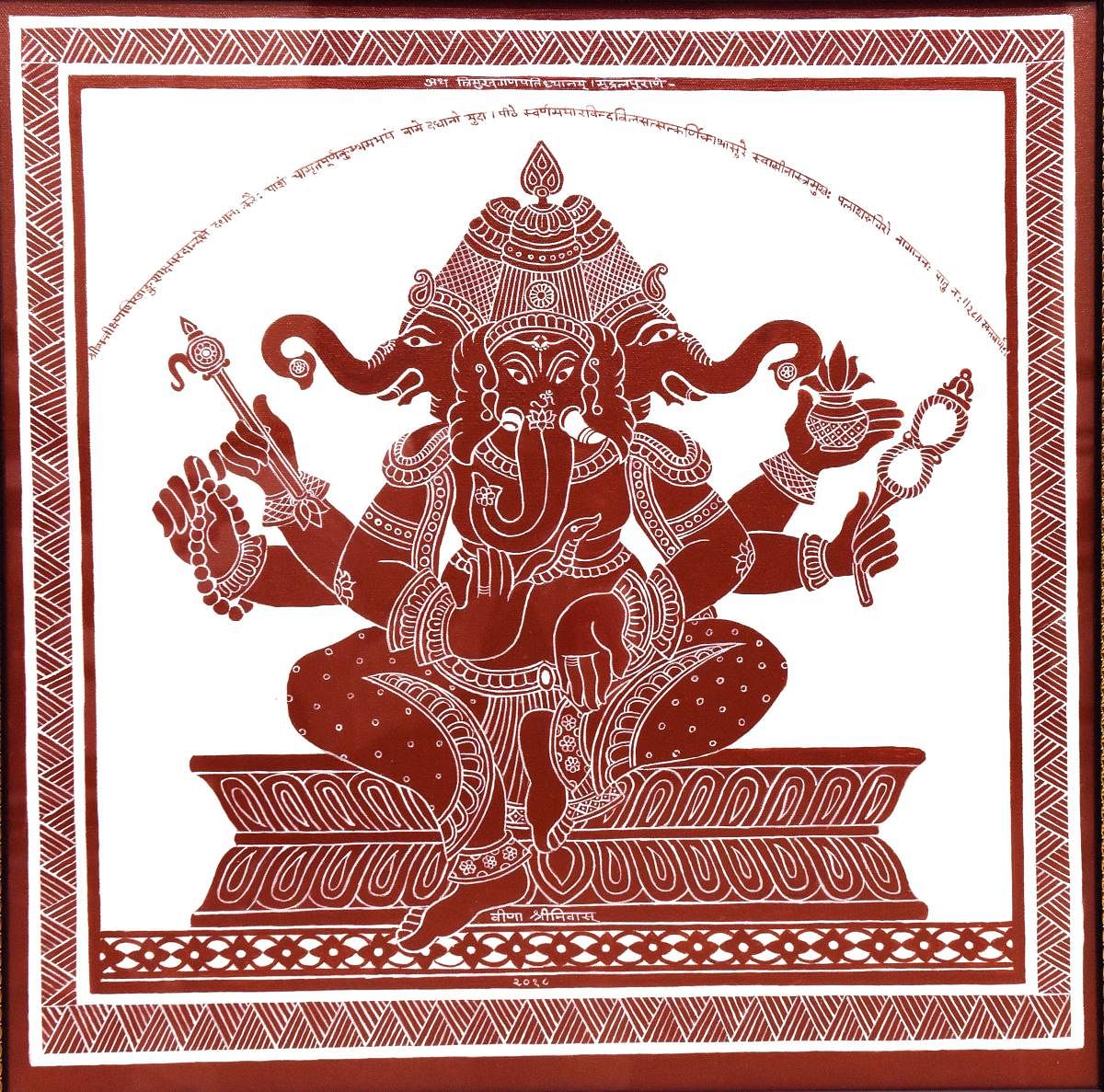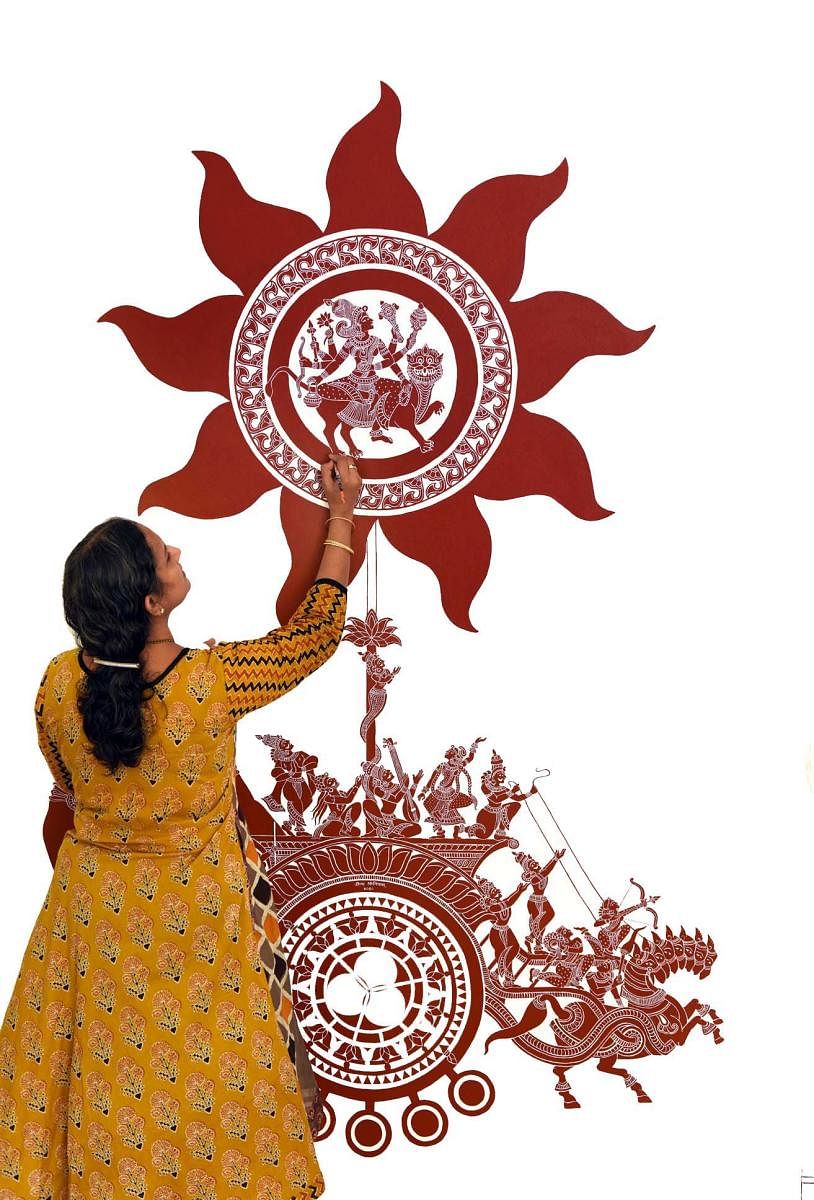
In recent days, teenagers in the coastal parts of Karnataka have a new-found pass time: learning kaavi kale, the murals in bright red and white shades. The traditional wall art that is rooted in coastal Karnataka over centuries has caught the imagination of youngsters in these districts in new forms. Artist Veena Srinivas, who has been conducting kaavi workshops and awareness programmes for children and elders, has given a contemporary touch to this art, without altering its originality.
Kaavi kale, that decorates houses, temple walls and churches, has been one of the several attractions of coastal Karnataka. This ancient art form is believed to have originated in 16th century in Goa. In Konkani, kaav means red, which is the predominant colour in these drawings. Originally, the red colour was derived from laterite soil. To provide a contrast background to red, a unique white amalgam is prepared using jaggery, seashells & river sand, which is then fermented for weeks. This compound is then applied on the wall on which this sketch is made. After a few hours of hardening, artists draw the sketches & etch out the lime compound inside the bordered area. The border is usually rectangular or circular in shape. This empty etched space is filled with kaavi or the laterite mix and then polished fine with stones for a smooth finish.
The origins
The kaavi art is said to have originated in Goa and found its way into coastal Karnataka, Maharashtra and Kerala through the Saraswat Brahmin community that migrated from Goa to the coastal districts of these states. They later built the temples for their deities and embellished them with kaavi paintings. The art which withstood high humid and rainy climate common in the coast soon became popular. Soon it crossed the religious barrier and found its way into the churches and households. We still can find churches and mansions with these sketches in the Konkan area.
As renowned researcher
K L Kamath who had done extensive research on kaavi kale in the coastal districts of Karnataka noted in his works, these mural artists were basically sculptors of the Hoysala era. These sculptors moved to the coastal districts after completing the temple work commissioned to them by the kings. They took up this art as a means of livelihood and soon mastered kaavi kale.
The size of these murals is generally between two-feet by three-feet to six-feet by six-feet. Apart from the walls, these sketches are also made window and door frames. While sequences from mythology are generally drawn, the artist uses nature and folk motifs for decoration. Though these drawings are more symbolic than realistic, the attention to detail is remarkable and some artists try to give a three-dimensional effect to the drawings.
K L Kamat wrote, “The kaavi art is a great example of monochrome mastery of Indian artists. The style adapted by the urban Kavi artist is radically different from that of the rural artists. Unfortunately, the Kavi artists have not left their identity anywhere. However, the themes of the murals are indicated in Devanagari script inside the panel. In some cases, records are available indicating the year in which the temple complex and its kaavi pictures were completed. In the Marikamba Devi Temple of Sirsi, the work was completed in 1689 AD.”
In decline
Over the years, Kaavi was replaced by enamel paint. As the demand declined, the artists, who mainly hailed from the lower middle class, found it difficult to make a living. And gradually, this wall art faded into oblivion. But of late, there has been a renewed interest in wall art. The Marikamba Temple in Sirsi, which is known for its murals, decided to retain the art in the early eighties. In the absence of traditional kaavi artists, the administration chose to rework on the original art with enamel paints thus saving the original art in a modern way. A few more temples followed this example and as a result, we can see traditional murals in the temples of Karwar, Kumta, Honnavar, Ankola, Siddapur.
Veena’s tryst with this art started with a visit to one such temple in Kumta. “It was in 2008 and for the first time, I saw an art of this sort. As it was a short visit, I had very little time and therefore with the permission of temple authorities I took photographs of a few paintings. On my way back, I glanced at these paintings and realised the amount of detailing involved. I wanted to take up drawing but was not sure which genre of painting I should engage into, till then. This trip helped me find my niche,” she says. After doing a bit of research on this art, she decided to revive it and was stuck with the idea of painting kaavi on canvas. “I used to participate in the art exhibitions in Mangaluru. As an experiment, I exhibited a few kaavi paintings along with my regular arts in one of the exhibitions. I got a very good response from the visitors. This was a morale booster and motivated me to engage more in popularising these paintings.” Since then, Veena has organised five solo exhibitions on kaavi art and participated in more than 20 exhibitions with her kaavi paintings.
“The responses to my works were encouraging. The old generation who knew the art lauded this effort and the new generation who came across for the first time showed interest to learn the art. A few school authorities too approached me requesting to train their students. I saw an opportunity to spread the art there and obliged. Till now, I have trained about 400 students and a batch of 50 students are being trained,” says Veena.
Sanjana Kamath, a 10th standard student from Mangaluru, who has been learning kaavi art from Veena, says, “I learnt the intricacies of this complex art from Veena and I would like to take it up seriously.”
Close to nature
Expert artist Dinesh Holla says, “Kaavi is a wonderful art close to nature. All the ingredients used here are natural products like mud, lime and plant leaves. Artists have used this art on temple walls to depict various characters and sagas of mythology.” But sadly, kaavi art did not get the same boost as other similar art forms such as Madhubani and Warli. It was largely ignored and didn’t get the required support. Dinesh says, “Innovation and right marketing strategies can help promote this art,” he says. He is appreciative of Veena’s efforts in promoting this art by bringing it on canvas. “In the name of renovations and modernity, we are destroying the murals. At least now we should wake up and promote kaavi on canvas. That is the only way I find to save it,” he adds.
Not all are happy with Veena’s
experiments. Some artists and art critics feel that kaavi is strictly a wall painting and bringing it on canvas will affect the traditional form. “There are people who are not happy with my work. Though art is always well-appreciated in its original format, when we don’t have traditional artists, we need to find a way to revive it in the best possible way. It is difficult to understand the right composition and methods for preparing kaavi art as we don’t have original practitioners now. We should upgrade ourselves with modern methods to conserve this traditional art. I am doing my bit to reintroduce our traditional form in a place where it thrived centuries ago. And What’s wrong with that?” says Veena. She has got a fellowship from the Union Ministry of Culture in support of her efforts.
After the conclusion of a kaavi exhibition in Manipal, Veena is preparing herself for what she says is her dream project: an exclusive kaavi exhibition on the Stree Shakti theme, featuring various Indian goddesses. With such efforts catching the attention of people, it’s just a matter of time before the art regains its popularity.
